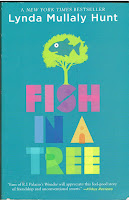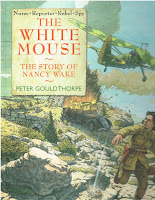
This week Patsy Jones gives us a detailed overview of this wonderfully stimulating and creative competition as it is run in Tasmania. The approximate dates for this year’s southern competitions have been set for June, and the books chosen for each level carefully selected. The CBCA Tasmanian Branch March newsletter contains a detailed report of the 2017 inaugural Devonport Reader’s Cup.
I have just this week attended a meeting of persons interested in the 2018 Readers’ Cup* competition in southern Tasmania – schools entering the competition must have Institutional CBCA membership. The dates have been set for the two competitions (Grades 5-6, and Grades 7-8) in June, and the six books (a mixture of fiction, picture-books, and non-fiction) to be used for each competition were identified after much careful discussion as to their suitability for the task.
 Here in
southern Tasmania, CBCA members have been organizing and managing these
competitions** since 2009 – so this must be the tenth year for us! Northern
Tasmania also provides an opportunity for such an annual competition, and has done
so for even longer – the northern competition is managed by the Tasmanian
branch of the Australian School Library Association (ASLA). Last year the
Devonport City Council planned and managed a very successful competition in the
north-west, with strong support from primary local schools, and we hope that
they will be planning another for this year.
Here in
southern Tasmania, CBCA members have been organizing and managing these
competitions** since 2009 – so this must be the tenth year for us! Northern
Tasmania also provides an opportunity for such an annual competition, and has done
so for even longer – the northern competition is managed by the Tasmanian
branch of the Australian School Library Association (ASLA). Last year the
Devonport City Council planned and managed a very successful competition in the
north-west, with strong support from primary local schools, and we hope that
they will be planning another for this year. Who here in
southern Tasmania is involved in the management and planning of Readers’ Cup? Representative
staff from interested schools, of course, but not just them – various parents
and grandparents who derive pleasure from reading the quality children’s
literature available here in Australia are prepared to carry out the necessary
tasks, as are various CBCA members; which comes first, the love of children’s literature,
or the assistance with the competition?
Who here in
southern Tasmania is involved in the management and planning of Readers’ Cup? Representative
staff from interested schools, of course, but not just them – various parents
and grandparents who derive pleasure from reading the quality children’s
literature available here in Australia are prepared to carry out the necessary
tasks, as are various CBCA members; which comes first, the love of children’s literature,
or the assistance with the competition? The
questions to be asked in the competition are written and prepared by volunteers
or invited community members who have read and carefully considered the books. An
MC is needed to ask the questions at each session (and there have been some
great MCs over the years – think Jenni Connor and Lyndon Riggall, among others).
Two or three judges are needed to mark the answers on the quiz sheets, and to
evaluate the creative work which teams present as part of the competition. And
it’s very helpful if there’s a person who can add the data to a spreadsheet as
the judges’ responses come in, so that the winning teams in each section (quiz,
creative, and total) can be identified before everyone has to head off back to
school ready to go home.
The
questions to be asked in the competition are written and prepared by volunteers
or invited community members who have read and carefully considered the books. An
MC is needed to ask the questions at each session (and there have been some
great MCs over the years – think Jenni Connor and Lyndon Riggall, among others).
Two or three judges are needed to mark the answers on the quiz sheets, and to
evaluate the creative work which teams present as part of the competition. And
it’s very helpful if there’s a person who can add the data to a spreadsheet as
the judges’ responses come in, so that the winning teams in each section (quiz,
creative, and total) can be identified before everyone has to head off back to
school ready to go home.
Without a
suitable venue the whole activity would be impossible, of course, and
interested and supportive schools volunteer their libraries or their school
halls for the occasion.
Patsy Jones
Retired Librarian and teacher
*The original Readers’ Cup competition was held in Colorado,
USA, and it was transplanted to South Australia in 1987. Several Australian states
have adopted it since then.
**If you want to know more about the Tasmanian CBCA
competition, find it on www.cbcatas.org ,
on the Events page. Find out when there
might be such a competition in your local area, and come along and enjoy the
day. Of course, if you have read the books beforehand, your enjoyment will be
even greater!














